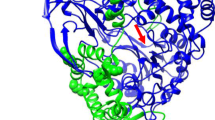Abstract
Penicillin acylase from Streptomyces lavendulae has been covalently immobilized to epoxy-activated acrylic beads (Eupergit C). Consecutive modification of the matrix with bovine serum albumin leads to a new biocatalyst (ECPVA) with enhanced activity (1.5 fold) in the hydrolysis of penicillin V respect to its soluble counterpart. This biocatalyst had a K m value of 7.6 mM, slightly higher than K m for native acylase (3 mM). In addition, ECPVA can be recycled for at least 50 consecutive batch reactions without loss of catalytic activity.
Similar content being viewed by others
References
Batchelor FR, Chain EB, Richards M, Rolinson GN (1961) 6–APA. IV. Formation of 6–APA from penicillin by enzymatic hydrolysis. Proc. Roy. Soc. Ser. B 154: 522–531.
Bradford MM (1976) A rapid and sensitive method for quantitation of microgram quantities of protein utilizing the principle of protein-dye binding. Anal. Biochem. 72: 248–245.
Chauhan S, Nichkawade A, Iyengar MRS, Chattoo BB (1998) Chainia penicillin V acylase: strain characteristics, enzyme immobilization, and kinetic studies. Curr. Microbiol. 37: 186–190.
Gestrelius S, Nielsen BH, Møllgaard H (1983) Continuous 6–APA and 7–ADCA production using SemacylaseTM (immobilized PEN-V acylase). Ann. N.Y. Acad. Sci. 413: 554–556.
Kluge M, Klein J, Wagner F (1982) Production of 6–aminopenicillanic acid by immobilized Pleurotus ostreatus.Biotechnol. Lett. 4: 293–296.
Møllgaard H, Karlsen LG (1988) 6–APA production in a pilot plant with an immobilized pen V acylase (SemacylaseTM). Ann. N.Y. Acad. Sci. 542: 360–365
Rolinson GN, Batchelor FR, Butterworth D, Cameron-Wood J, Cole M, Eustace GC, Hart MV, Richards M, Chain EB (1960)Formation of 6–APA from penicillin by enzymatic hydrolysis. Nature 187: 236–237
Shewale JG, Sivaraman H (1989) Penicillin acylase: Enzyme production and its application in the manufacture of 6–APA. Process Biochem. 24: 146–154.
Shewale JG, Sudhakaran V (1997) Penicillin V acylase: its potential in the production of 6–aminopenicillanic acid. Enzyme Microbiol. Technol. 20: 402–410.
Singh D, Goel R, Johri BN (1988) Deacylation of penicillins by the immobilized mycelia of the termophilic Malbranchea. J. Gen. Appl. Microbiol. 34: 333–339.
Sudhakaran VK, Shewale JG (1993) Enzymatic splitting of penicillin V for the production of 6–APA using immobilized penicillin V acylase. World J. Microbiol. Biotechnol. 9: 630–634.
Torres R, de la Mata I, Castillón MP, Arroyo M, Torres J, Acebal C (1998) Purification and characterization of penicillin V acylase from Streptomyces lavendulae. In: Ballesteros A, Plou FJ, Iborra JL, Halling PJ, eds. Progress in Biotechnology, Vol. 15: Stability and Stabilization of Biocatalysts. Amsterdam: Elsevier, pp. 719–724.
Torres R, Ramón F, de la Mata I, Castillón MP, Acebal C (1999) Enhanced production of penicillin V acylase from Streptomyces lavendulae. Appl. Microbiol. Biotechnol. 53: 81–84.
Author information
Authors and Affiliations
Rights and permissions
About this article
Cite this article
Torres-Bacete, J., Arroyo, M., Torres-Guzmán, R. et al. Covalent immobilization of penicillin acylase from Streptomyces lavendulae. Biotechnology Letters 22, 1011–1014 (2000). https://doi.org/10.1023/A:1005601607277
Issue Date:
DOI: https://doi.org/10.1023/A:1005601607277




